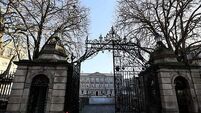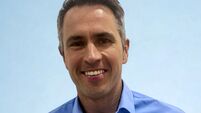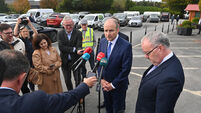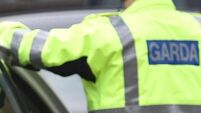Political push behind deregulation
As people apply for the licences the industry will grow and the service to the public will become a reliable one and there will be taxis when they are required.”
Across the road from the Dáil in Buswells Hotel sat general secretary of the National Taxi Drivers’ Union, Tommy Gorman, and other representatives of the country’s then fewer than 5,000 taxi drivers.
“We had been told to be available for a phone call and member of Molloy’s department phoned and said he had deregulated the business. We were in shock, we knew it was coming in some form but just to have it happening like that, people’s livelihoods destroyed, it was incredible.”
The next phone call Gorman received was from Limerick drivers, several dozen of whom were on their way to Dublin to blockade the airport. The next day, vehicle access to the airport was blocked as well as the Dáil, the M50 and main Dublin to Belfast road.
Across the country cabbies protested, in Limerick 40 drivers barricaded the chemist shop of PD councillor Tim O’Malley, while Cork’s then 216 cabbies went on strike, only providing services to hospitals and the blood bank.
The following week saw 3,000 taxi men march on the Dáil with a violent confrontation where cabbies broke through police lines being christened the “Battle of Nassau Street”. These events set the tone for a decade which would see taxi numbers rise from 5,000 to more than 25,000 countrywide and cabbies regularly protesting against the Government and its agencies.
Taxi deregulation had its roots in a number of reports in the late 1990s. These had concluded that unlike other countries, where taxi licensing had been employed to ensure high standards of vehicles and drivers, in Ireland, and particularly Dublin, the system had been utilised to prevent the supply of taxis matching the demand.
Since 1978, when taxi drivers won a court case to restrict their numbers, very few taxi licence “plates” had been issued by the country’s various local carriage offices. Successive governments had shown little interest in reforming the industry largely due to the success of the taxi business in lobbying politicians, particularly Fianna Fáil representatives. However, the country’s rapid economic growth had significantly increased taxi demand.
With plates only allowing taxis to operate in specific geographical areas, the supply problem in Dublin was becoming particularly acute with demand outstripping cities of similar size due to the capital’s low population density, low public transport provision (subsidies for bus transport being a fraction of what they were in most developed countries) and a high level of tourist activity.
F But in Dublin, only 100 new licences had been issued in 1991 with a further 50 for wheelchair-accessible cabs in 1992. In total between 1978 (when the regulation system began) and 1997 Dublin taxi numbers had only increased by 7.5%, from 1,835 to 1,976.
Conversely the number of hackney cabs, vehicles licensed to carry passengers but not display signs, use radios or pick up roadside business, had ballooned from 800 in 1992 to more than 3,000. Cork, with a taxi fleet of about 200, was felt to be in a less acute position, partly because the council had adopted the findings of a 1979 transportation report which had resulted in a more structured development of the city’s public transport system.
The sheltered taxi licence market had resulted in plates providing a very high financial return, this in turn saw their value rise until in 2000 they were fetching more than IR£80,000. In some instances wealthy individuals, often with close political connections, had accumulated several licences and were employing drivers — so called “cozies” — to actually work the taxis.
Although such multi-licence owners were in a minority, with most individual plates supplying the main source of income for their owners, their role became crucial in the debate over the industry’s future.
This saw the free-marketer PDs pitted against their government coalition partners — in particular a cabal of Fianna Fáil TDs, largely from Dublin’s north side, that included Ivor Calley and Noel Ahern, but also others such as Limerick’s Willie O’Dea, who set themselves against significant change in taxi provision.
A northside of Dublin taxi driver in the 1980s recalls the close relationship the industry had with some Fianna Fáil politicians: “At election time taxi men would help put up party posters and ferry voters to the polls, this assistance was provided to politicians and they helped protect the taxi industry.”
But as the queues for taxis grew, the power of this lobby began to wane.
Public displeasure with the industry was amplified by the PDs’ allies in the media and bodies such as the Competition Authority who in their push for deregulation latched on to the bogeyman of the multi-plate owners.
A 1998 Competition Authority report demanded the liberalisation of the market and an end to the transfer of taxi plates, comparing plate owners who received rent payments from cosy drivers to “urban sharecroppers”, who forced people to work up to 70 hours a week for only the minimum industrial wage. Another report estimated that taxi users were paying at least IR£12 million a year more than they would in a free market.
In the media, examples such as the taxi market in New Zealand and even the largely paramilitary controlled enterprises in Belfast were raised as examples of what could be achieved in providing a cheap and efficient service.
By February 1999, taxi deregulation was stated PD policy while, in an attempt to appease his political allies, Taoiseach Bertie Ahern had separately established a broad-based Dublin Taxi Forum, which facilitated talks between the various industry stakeholders.
Taxi unions were set against a major shake up of the industry, president of the Irish Taxi Drivers’ Federation John Usher, stating that: “80% of drivers have borrowed to pay for plates and I know many who’ve re-mortgaged their homes to pay for them,” a reality that was in stark contrast to the media portrayal of taxi men.
By the turn of the millennium, the Dublin Taxi Forum had agreed to the staggered release of 750 more taxi licences. In early 2000, Molloy announced a scheme designed to increase by 3,100 the number of taxi licences in Dublin within a six-month period by issuing a second licence to all individual plate holders and 500 to “cosy” drivers. It was a grudging political compromise between Fianna Fáil and the PDs designed to protect, so far as possible, the interests of existing licence holders. But a successful legal challenge to its terms by hackney drivers, seeking full deregulation, scuppered it.
On October 13, Mr Justice Murphy upheld their challenge and ruled the Government had no power to restrict the issuing of new taxi licences to holders of existing licences. The court judgment stated: “A quantitative restriction not alone affects the rights of citizens to work in an industry for which they may be qualified but it also manifestly affects the right of the public to the services of taxis and, indeed, restricts the development of the taxi industry itself.”
The PDs had succeeded in the first stage of an ideologically driven deregulation programme that they hoped would spread to the public house market, pharmacies, banking, airports, broadcasting, health insurance and milk production.
On December 8, 2001, after 17 angry days on strike, taxi men went back to work. Cork cabbies were among the first to return following two operators representing about 200 plate owners in the city and Mallow being granted leave to take a legal challenge to deregulation.
The court case opened with affidavits from taxi-drivers stating they had bought plates for between IR£28,000 in Limerick, IR£70,000 in Cork and IR£107,000 in Clare. All claimed to be fearful of not being able to make a living after deregulation.
Running concurrent to their court challenges the leaderships of the three taxi unions or representative bodies — the Irish Taxi-Drivers’ Union, SIPTU and the Irish Taxi Drivers’ Federation — met Molloy for discussions. The court cases and discussions brought little change in government policy.
In the weeks following deregulation, it emerged that out of the 2,721 taxi licences in Dublin 77 licences were officially in multiple ownership. Bill Rogers, whose family had control of 14 plates, said the situation was “worse for the people with one licence than for me, it is their sole reliance... the men came to rely on the licence as an asset for their children and as a pension”.
Gorman recalls the impact of deregulation on what had been a tight-knit driver community. “A lot of people sold their homes in Dublin, and uprooted their children and moved to cheaper houses in the country so they could pay off loans they had taken out to buy a now useless asset. It caused a lot of problems in the business, there were suicides, deaths and a lot of marriage break-ups.”
The Government agreed to compensate fully the 800 drivers who had purchased wheelchair accessible licences for up to IR£15,000 in the three years leading up to deregulation. The remainder were initially offered tax write-offs on the depreciation in the value of licences but in February 2002 a Taxi Hardship Board was established to adjudicate on compensation for those hard hit including widows, people who had taken out large loans to buy licences, older people and those in ill health.
The Taxi Hardship Board’s report, offering payments of up to IR£15,000, out of a pot of £15 million, for those worst affected was described as an “insult” by taxi representatives who said IR£315m worth of members’ assets had been wiped out.
Deregulation had emerged as a solution to a Dublin problem, a fact not lost on taxi men in other regions. At the time NUTD Limerick spokesman Paul Hayes said “to solve a Dublin problem” they had ruined the business — “they have used a sledgehammer to crack a nut”.
Regional drivers pressurised their TDs. One supposed champion was junior minister Willie O’Dea, who took to local radio in Limerick to damn the Government’s policy and rowed with Molloy in the corridors of Leinster House.
O’Dea’s subsequent climbdown was comical. Responding to a Fine Gael motion calling for his removal from office, O’Dea told the Dáil: “Whatever my private views on this issue I fully support Government policy — I want to be unequivocal about that.”
With regard to an address to 400 taxi men and their families in Limerick, he added: “If I had known my remarks were being taped and directly transmitted to the Minister of State, Deputy Molloy and others, I would, of course, have moderated my tone and been less offensive and insulting.”
Beyond the Fianna Fáil backbenchers there was general political support for deregulation, only Labour’s Michael D Higgins breaking ranks commenting that the move amounted to “a Third World option in transport”.
The public and businesses also widely applauded the reform of the industry, the Competition Authority stating that to call it “deregulation is misleading”, “regulatory reform is a better description, because only one element, entry, is liberalised, while fare controls are maintained and quality standards improved”.
Molloy’s new legalisation certainly had the effect of increasing taxi licence numbers. Within two months of deregulation 740 new taxi licences had been issued by Dublin Corporation and 90 by Cork City Council, while taxi numbers in Limerick had risen by 56% to 325. By the middle of 2001 there would be nearly 2,000 more licences than prior to deregulation in Dublin, a few months later 5,000 more.
Most of those securing licenses had been part of the service as cosy or hackney drivers, whereas prior to deregulation many plates had been in operation 24 hours a day, part-time taxi working became more widespread. A June 2001 survey found that the capital’s taxi service remained “remarkably poor”. At weekend peak periods it was estimated average waiting times at College Green were 55 minutes between 2am and 3am on Sundays and 91 minutes between 3am and 4am.
The issue remained on the public agenda, even spawning its own Carlsberg ad, where amazed night club goers emerged to see a long row of taxi cabs on a Dublin street, a sight unthinkable at the time.
A new media bogeyman, the criminal taxi driver, also began to emerge, with reports of violence and abuse being directed at passengers. Fine Gael spokeswoman on traffic, Olivia Mitchell, claimed that 20% of taxi applicants since deregulation had criminal convictions, with an election close her party also offered to make IR£400m available to compensate drivers.
Though the gardaí confirmed the legalisation meant those with criminal convictions could not be stopped becoming drivers, the number of complaints to gardaí about cabbies per capita had remained static. In 1999, before taxi deregulation, when there were under 3,000 taxi drivers in Dublin and 300 complaints were made. In 2002 509 made complaints, but there were about 7,000 taxi drivers on the road.
Molloy paid little attention to concerns about quality. As a Policy Institute report put it: “Deregulation of entry would need to be accompanied by measures to ensure quality standards and efficient organisation of the market”, but this had not occurred. Though certain improvements in service had been envisaged, such as the installing of electronic meters that would issue receipts and a limit on the age of cars that could be employed as taxis, the reforms were put on the long finger.
FOR 20 years, Robert Lynch has been making a living from driving a taxi. Prior to November 2000, the Cork city driver worked three shifts a week with a taxi company.
“There would be a shortage of taxis on a Friday night and Saturday night, but what really happened was you had the pubs and the clubs all coming out at the one time, you had too many people on the streets all wanting a taxi straight away,” he recalls.
When deregulation was introduced, Robert got a loan and bought his own plate and car. Separated and in a second relationship, he could initially help support both households and “had a good life”. “I didn’t have a great life, but a good life.”
But things began to change. “We were all sold a pup that didn’t grow. We were told go out and become self-employed, better your lives. It was grand for the first two-and-a-half years but then people started coming in who are working in Pfizer or in the army, school teachers buying taxi plates and then coming out at the weekend and destroying our living.
“If I had a mortgage, I wouldn’t be able to survive. There is a load of lads that sit in my car and they just break down, they don’t see their wife or kids. People don’t listen to us; they think we are lying. There is a lot suffering diabetes and heart problems and this is all down to pressure.”
The situation is so desperate that Robert says “unfortunately some fellas have turned to suicide”.
Robert and his Cork taxi driver colleagues recently spent time looking for a cabbie who abandoned his car and was missing for two weeks. They fear the worst.
The problems in the industry are only increasing. “What is damaging taxiing now is the people with the multi-plates. People are finding it very tough in the last two years and fellas are having to sell out their plates, you can buy a plate now for €1,200 or €1,400 and you have fellas out there wiping them up and leasing them out to fellas who can’t get loans and what have you. Fellas are leasing taxis and working seven days and seven nights.”
The competition is increasing even further because of changes brought in by the taxi regulator to regularise taxi plate identification. “Before, if I was moving from Cork, I would have had to sell my taxi plate, but now you can do what you like with your plate and that is the danger. The regulator will tell you there are 1,500 taxis operating in Cork, but she is not counting the taxis that are coming up from smaller towns at the weekend.”
MICHAEL BLANCH has driven a Dublin taxi since the early 1980s. He is also the organiser of the Black Ribbon protest campaign to highlight the issue of suicides among cab drivers.
“I bought my plate in 1981; because of the recession in the ’80s, you had lean times. In 1978 you could go down and get your plate for a few hundred pounds, but from ‘78 on it was kind of a closed market. From the 1980s to deregulation, plate costs went from a couple of thousand to £80,000.
“The sad part about the deregulation was there was kind of whispers about it, but people were still buying plates, and then it came in overnight and there was people who bought plates for £80,000 on the very eve of deregulation, they were not given any warning.”
Micheal believes the reform of the industry could have been handled differently. “In the ’90s, it was a good business, with the taxi forum they were letting out a number of plates at a certain rate. It could have been more and that is the sad thing about it.
“Like anything in life you have to get a balance, an equilibrium about what you’re doing. There was a shortage, there is no doubt about it. What they should have done was sit down with the drivers and let out X amount to try and see what was a liveable wage for a taxi drivers while accommodating the public, but what they done was they just flooded the market.
“It was getting harder and harder and harder to get a few bob but then two years ago the industry just hit a wall. Luckily my family is reared, so the problems of the downturn personally I’m coping, but younger people who have young families and have bought houses at the top end of the market they are bearing the brunt of the stress now.
“Not only do we have the growing problem of suicide among drivers, with 34 having taken their own lives in recent times, but you have guys doing terrible amounts of hours of work and it really is becoming a health and safety issue.”
The changes with the industry has not only brought economic problems but also a social fragmentation of the taxi industry.
“When there was the 2,700 plates in Dublin, the majority of guys knew one another, they helped one another no matter what the situation. If there was a bit of bother on the rank, if people broke down there would be help. There was camaraderie.
“There are guys now, you won’t see them for months and you say to them ‘I thought you have got out of the business’ and they say ‘I thought you did’. People are now going into a shell.”
Through his work, Micheal is acutely aware of the calamity which has befallen the taxi industry and the resultant human cost is a precursor of what is now happening in wider society.
“It is not only taxi drivers being driven beyond despair, the human cost of what has happened to the economy is coming to the fore for all ordinary people.”
IRELAND and, in particular, its capital, has been saturated with taxis. In Dublin on any day you have over 13,500 licensed taxis working with approximately 4,000 taxis from outside the capital also working. A large number of these taxis are illegal. New York and its five boroughs have over 14 million people. London has in excess of 10 million people, yet they only have a similar number of taxis.
Dublin’s taxi ranks can only hold around 5,000 taxis. Due to the numbers of taxis attempting to use ranks, drivers are being forced to park in illegal areas and being fined. One driver received two fines the day before he took his own life.
The key concern of any public transport service should be safety for the public and service providers: this is not the case for the Irish taxi industry. The Taxi Regulator has removed from taxi roof signs the regional identification which showed the area in which they were legally licensed to work. This is making it easier for cowboy drivers who clone cars and work uninsured. Before the identification was removed it was easier for taxi drivers to recognise those working illegally and report them.
Another change that is being abused is the issuing of multi-identifications to the same taxi drivers. We have many reports of these IDs being used by others. If only one licence was issued at a time it would not be possible to do this. Most of these problems concerning illegal operators apply late at night. We requested a 24-hour emergency number from Taxi Regulator Kathleen Doyle. We are still waiting for this number; meanwhile, safety continues to deteriorate.
Since deregulation many taxi plates are being farmed out to people that do not have the credentials to drive taxis. Taxi plates now sell for €2,000 and some companies rent licensed vehicles from their owners for a pittance and have three people working them.
Deregulation has had to be reversed in many countries.
Any system that is forcing drivers to work 14 or 16 hour shifts is jeopardising the safety and the quality of the services. The lack of ranks has resulted in many taxis being reduced to circulating around the city with the associated environmental problems. This is the sort of disarray the industry has been left in after 10 years of deregulation.











